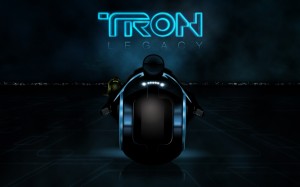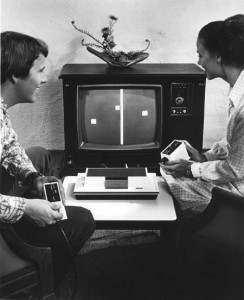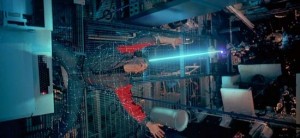 Rating: Two and a half stars (out of four)
Rating: Two and a half stars (out of four)
It’s hard to imagine what it must have felt like to be there in August 1939. When Dorothy first left the flat, gray landscapes of Kansas and stepped into the vibrant land of The Wizard of Oz, theater audiences went with her, and they discovered a world unlike anything they’d seen on a screen before. Talkies were commonplace by then, and even three-process Technicolor had seen its fair share of use, but the effort that went into realizing the full potential of both resulted in an Oz that must have felt astonishingly real, and above all, new.
In the way that it showcased the potential of new filmmaking technology, 1982’s Tron followed in Oz’s footsteps – and the similarities don’t end there. The Master Control Program serves as both the tornado and the Wicked Witch – an incomprehensibly powerful destructive force that pulls the protagonist into a novel realm, and which the protagonist must eventually defeat to return home. Like Dorothy, Flynn finds himself lauded as a hero, but must travel across the dangerous but engaging new world, making friends along the way that look like his friends back home. Hell, they both even have to contend with The Great and Powerful Giant Floating Head.
So why has The Wizard of Oz stood the test of time, while Tron remains a footnote? Why is it that cinemaphiles and casual viewers alike recall one film with fondness, while the other is most often remembered as “that one level from Kingdom Hearts – or was it Kingdom Hearts 2?” And in light of that disparity, why make a Tron: Legacy at all?
Most of this can be chalked up to the way each project was approached. Oz was already a much-beloved novel and stage play before it was adapted to film. In fact, it had made it to the big screen numerous times before the technology that enabled the 1939 version’s memorable visuals was available, and the production team reportedly spent much of their time ironing out Technicolor’s limitations even then. In contrast, Tron’s writer-director pretty much just saw somebody playing Pong and set to work making his dream, as it were, a reality. Mix those backwards priorities with the enormous improvements in CGI over the 30 years since then, and you’ve got a recipe for a film that won’t age well.
With the bar so low, one can’t help but ask: why Tron: Legacy? Why now? Most of us have grown up in a world where movies of all kinds are routinely augmented with CGI – in fact, the two first movies I remember seeing in theaters, 1992’s Batman Returns and Aladdin, both were praised for the way they incorporated computer imagery into live action and traditional animation, respectively. And between the underwhelming animated features studios are fond of churning out and the live-action films with hasty post-production, Legacy’s other Oz-style gimmick, 3D, is already somewhat unremarkable. In fact, it’s been more than a year since Avatar took both to heights that Tron: Legacy couldn’t hope to surpass.
From a historical perspective, then, Tron: Legacy isn’t just a sequel – in fact, it’s more of a reboot. It represents a promise – 1982’s Tron’s promise – fulfilled. It’s a dazzling and completely novel universe fully realized using a mature, and yet still cutting-edge, technology, and it has a plot that, at the very least, helps move things along, without the frequent pauses to marvel at the Grid that delayed the original’s pacing.
You’ll notice that we’re six paragraphs in, and I’ve only just begun to mention the plot. That’s because it’s fairly unremarkable. We move quickly from a thankfully brief treatment of intellectual property ethics (the message of “information wants to be free, maaaan” is surprising when one considers Disney’s zealous copyright enforcement) to the film’s main conflict: twentysomething Sam (Garrett Hedlund) is searching for his father, Flynn (Jeff Bridges), who has disappeared years ago. After hearing about a page from Flynn’s arcade office, he does a little digging, and before long he’s shooting himself with a laser and is sucked onto the Grid. You read that right: Sam isn’t pulled into magic computer town by some nefarious force; he simply sits down at a computer, sees that it’s hooked up to a laser, thinks “what the hell, why not” and fires it into his back.
It’s only after Sam meets his father and hears the whole backstory that things start to get weird canon-wise. I can’t wrap my mind around the events of 1982’s Tron happening in the same universe as Legacy. By the end of the movie, I was convinced that the only elements they’d kept from the first were
- Flynn worked at a software company called Encom with Alan,
- Computer games put Encom on the map, and
- Flynn wants to get all up in one.
The Master Control Program doesn’t even get a mention, other recurring characters all seem to be retconned as creations of Flynn’s new Grid, not the all-encompassing Grid on which all software lived and died in Tron, and “Disc Wars” is clearly inspired less by Tron’s digital Jai Alai and more by the classic Ricochet mod for Half-Life. But the change is a good thing; the universe is a lot more engaging than it could have been if Legacy spent its time explaining how our digital world fit with Tron’s universe (“Where’s World of Warcraft on the Game Grid?”). And there are more than enough wink-winks toward the audience to please the Tron faithful. My favorites: Sam lives in a modified storage container from “Dumont Shipping,” a reference to the input-output program that let the original Tron (Bruce Boxleitner in both movies) receive instructions from his user, and Cillian Murphy makes a cameo as Dillinger’s son, a rising star at Encom and the most aggravating hipster this side of a BlackBerry commercial.
All in all, Tron: Legacy makes for a confusing sequel for those who remember it, but it’s a satisfying reimagining of the original Tron, and that lends an appeal to audiences much broader than the aging geeks and camp fans that a straight sequel would have been largely limited to. The story is paced well enough to keep things moving, and the visual effects and 3D are engaging and vibrant, but a masterpiece it ain’t. It may not be Oz, but Tron: Legacy’s Grid will have an impact on our conceptions of what a movie universe can strive to become for some time.







Tron, in my mind, was an under-watched cult classic. I’m not saying it should have been watched more, I’m just saying that it somehow achieved cult status without being watched by many people. If more people had watched it, they would have seen how little Disney had to work with to create a sequel, and why they had to totally reinvent the proverbial digital world. Your points were really interesting, and I enjoyed reading the article. I’m not going to say that Tron: Legacy is the best movie of all time, or even the best movie of 2010, but it certainly creates a much more awesome universe with the concept that is Tron. (On a more personal note, I could not get through this movie without thinking about Jeff Bridges as the Big Lebowski. “Whoa, there is a beverage here, man.” Half-Hippy, Half-Jesus analogue that fits Flynn’s character perfectly)
Pingback: Tron: Legacy review at EarnThis. – Wm. Hunter Dot Com